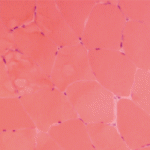Advantages & Limitations
One subgroup of patients that may be classified with polymyositis may have immune-mediated necrotizing myopathy (IMNM), “which was hardly recognized when we started our project,” said Dr. Lundberg. Based on the 2016 European Neuromuscular Center workshop report, IMNM includes three subsets: anti-SRP myopathy, anti-HMGCR myopathy and antibody-negative IMNM.2 Anti-SRP and anti-HMGCR myopathy include patients with high CK, proximal muscle weakness and either anti-SRP or anti-HMGCR antibodies. The antibody-negative IMNM classification includes high CK; proximal muscle weakness; muscle biopsy features (including scattered necrotic fibers); different stages of necrosis, myophagocytosis and regeneration; and macrophages, but few lymphocytes.
Future EULAR/ACR classification criteria should include other missing myopathy subsets, including the antisynthetase syndrome, said Dr. Lundberg.3 These patients are a subset of either DM or PM, have anti-tRNA synthetase autoantibodies, and characteristically have myositis, interstitial lung disease, arthritis, fever and Raynaud’s phenomenon, she said.
When Dr. Lundberg and her colleagues tested the criteria using a cohort at their hospital, they found that compared with the Bohan and Peter criteria published in 1975,4 the new criteria show a higher percentage of definite cases (65% to 42%). However, 12.3% of cases could not be classified, compared with 7.10% under the previous criteria, “mostly because there is missing information in our registry, such as biopsy data,” she said.
“There are limitations with the new criteria. Of the new autoantibodies we have recognized, only anti-Jo-1 antibodies made it into the new criteria due to the low number of tested individuals for the other autoantibodies in the classification criteria cohort,” said Dr. Lundberg. “Patients with interstitial lung disease, but without muscle weakness and anti-Jo-1 antibodies, may not be classified as IIM with these criteria. Some new subtypes could not be identified,” such as IMNM and the antisynthetase syndrome. “We also need to validate the criteria in an external cohort with cases and comparators. This is in the pipeline.”
Diagnostic workup for a patient with possible myositis includes both clinical observation of specific skin rashes and muscle weakness, she said. The Manual Muscle Test 8 (MMT8) strength test often is used, but rheumatologists should add the Functional Index of Myositis test, which counts muscle repetitions in seven muscle groups, for more sensitive detection of weakness that takes fatigue into account, she said (see Tables 1).5
“In typical cases, you have signs of myopathy, but also have elevation of muscle enzymes. But a normal CK does not exclude myositis,” said Dr. Lundberg. “An EMG [electromyography] and muscle biopsy may be helpful, where you can see signs of inflammation, degeneration, necrosis and regeneration of muscle fibers.”
Patients who have anti-Jo-1 antibodies may present with different organ manifestations, and recent research shows other myositis-specific autoantibodies, including anti-MDA5, anti-NXP2 and anti-SAE, may present with skin rash without muscle weakness.6,7 Normal CK and even normal biopsy results do not exclude diagnoses like dermatomyositis. Additional tests, such as immune staining for MHC, magnetic resonance imaging (MRI) to look for edema or to help guide biopsy, EMG, muscle enzyme tests and testing for myositis-specific autoantibodies are helpful for diagnosis, as well as pulmonary function tests if patients also present with lung symptoms, she said.

